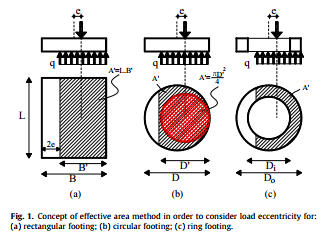nicoga3000
Civil/Environmental
I have been looking into the Effective Area Method outlined in NAVFAC DM7-02 for rectangular and circular footings. However, for instances of designing foundations for silos or similar structures, ring type foundations are typically used (circular foundation with an outside and inside radius). Does anyone have any experience with or documentation on how to utilize the Effective Area Method for shapes like that? I know it CAN be done as I've seen results for it, but I've never been able to determine the method applied.
Also, for use of FEA for large foundations, I've found a few issues with designs. Typically, I use a simple P/A + My/I for determining service bearing. When using FEA, the same foundations that work under my method tend to have local bearing failure due to concentrated pressure directing under larger loads. Is this typical? Are there provisions to deal with this out there?
Also, for use of FEA for large foundations, I've found a few issues with designs. Typically, I use a simple P/A + My/I for determining service bearing. When using FEA, the same foundations that work under my method tend to have local bearing failure due to concentrated pressure directing under larger loads. Is this typical? Are there provisions to deal with this out there?

